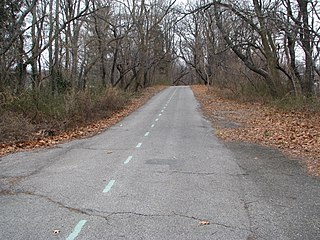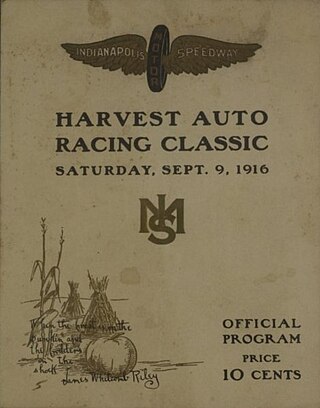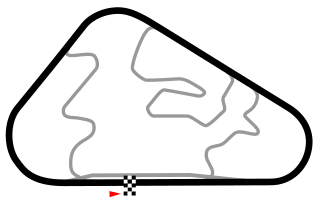
The Long Island Motor Parkway, also known as the Vanderbilt Parkway, Vanderbilt Motor Parkway, or Motor Parkway, was a limited-access parkway on Long Island, New York, in the United States. It was the first highway designed for automobile use only. The parkway was privately built by William Kissam Vanderbilt II with overpasses and bridges to remove most intersections. It officially opened on October 10, 1908. It closed in 1938 when it was taken over by the state of New York in lieu of back taxes. Parts of the parkway survive today, used as sections of other roads or as a bicycle trail.

Pierre Raymond Sommer was a French racing driver. He raced both before and after WWII with some success, particularly in endurance racing. He won the 24 Hours of Le Mans endurance race in both 1932 and 1933, and although he did not reach the finishing line in any subsequent appearance at the Le Mans, he did lead each event until 1938. Sommer was also competitive at the highest level in Grand Prix motor racing, but did not win a race. He won the French Grand Prix in 1936, but the event that year was run as a sports car race.
Grand Prix motor racing, a form of motorsport competition, has its roots in organised automobile racing that began in France as early as 1894. It quickly evolved from simple road races from one town to the next, to endurance tests for car and driver. Innovation and the drive of competition soon saw speeds exceeding 100 miles per hour (160 km/h), but because early races took place on open roads, accidents occurred frequently, resulting in deaths both of drivers and of spectators. A common abbreviation used for Grand Prix racing is "GP" or "GP racing".
Clément-Bayard, Bayard-Clément, was a French manufacturer of automobiles, aeroplanes and airships founded in 1903 by entrepreneur Gustave Adolphe Clément. Clément obtained consent from the Conseil d'Etat to change his name to that of his business in 1909. The extra name celebrated the Chevalier Pierre Terrail, seigneur de Bayard who saved the town of Mézières in 1521. A statue of the Chevalier stood in front of Clément's Mézières factory, and the image was incorporated into the company logo.

Oval track racing is a form of motorsport that is contested on an oval-shaped race track. An oval track differs from a road course in that the layout resembles an oval with turns in only one direction, and the direction of traffic is almost universally counter-clockwise. Oval tracks are dedicated motorsport circuits, used predominantly in the United States. They often have banked turns and some, despite the name, are not precisely oval, and the shape of the track can vary.

The Grand Prix of Long Beach is an IndyCar Series race held on a street circuit in downtown Long Beach, California. It was the premier race on the CART/Champ Car World Series calendar from 1996 to 2008, and the 2008 race was the final Champ Car series race prior to the formal unification and end of the open-wheel "split" between CART and IRL. Since 2009, the race has been part of the unified IndyCar Series. The race is typically held in April. It is one of the longest continuously running events in IndyCar racing and is considered one of the most prestigious events on the circuit.

Piero Taruffi was an Italian racing driver. He raced in Formula One from 1950 to 1956, winning the 1952 Swiss Grand Prix and finishing 3rd in the 1952 World Drivers' Championship. His most notable motorsports victory was the 1957 Mille Miglia, the final running of the cross-country sports car race.

The Vanderbilt Cup was the first major trophy in American auto racing.

Charles Cleveland Merz was an American racing driver, military officer, engineering entrepreneur, and racing official. Active in the early years of the Indianapolis 500, he later became Chief Steward of the Memorial Day Classic.
Lee Ambrose Frayer was an American racing driver who competed in the 1911 Indianapolis 500. Driving a Firestone-Columbus automobile, Frayer won a 100-mile race in Columbus, Ohio, defeating, among others, the great Barney Oldfield.
The 1906 Grand Prix season is regarded as the first Grand Prix racing season. It marked the advent of two iconic races: The French Grand Prix and the Targa Florio.

The 2009 IndyCar Series was the 14th season of the IndyCar Series. The 17-race season began on April 5, and its premier event, the 93rd Indianapolis 500 was held May 24. All races were broadcast on ABC or Versus in high-definition. It represented the 98th recognized season of top-level American open wheel racing.

The 94th Indianapolis 500 was held at the Indianapolis Motor Speedway in Speedway, Indiana on Sunday, May 30, 2010. It was the 15th Indy 500 sanctioned by the Indy Racing League, and was the premier event of the 2010 IZOD IndyCar Series season. The race was won by Dario Franchitti, ahead of Dan Wheldon and Marco Andretti. Tony Kanaan, who had started in the final position, ran as high as second during the race before finishing eleventh.

The 2011 IZOD IndyCar Series was the 16th season of the IndyCar Series and the 100th recognized season of American open-wheel motor racing. The season was sanctioned by IndyCar and was part of the Mazda Road to Indy. The season began in March and concluded in October, consisting of seventeen events.

Tom Cooper was an American cyclist and early automobile racing driver. He is best known for his rivalry with cyclist Major Taylor, as well as his later work with Henry Ford and Barney Oldfield.

The Harvest Auto Racing Classic was a series of three automobile races held at the Indianapolis Motor Speedway on Saturday September 9, 1916. The meet, held four months after the 1916 Indianapolis 500, featured a 20-mile race, a 50-mile race, and a 100-mile race. The main event, a 100-mile Championship Car race, paid points towards the 1916 AAA National Championship. Johnny Aitken won all three races, two of which had a margin of victory of less than a car length.

Albert Clément was a French motor racing driver. In 1904 he won the II Ardennes Cup race and finished third in the III Ardennes Cup race at Bastogne. He also finished second in the Vanderbilt Cup on Long Island. In 1906 he finished third in the inaugural French Grand Prix and 4th in the Vanderbilt Cup. All his driving was in the Clément-Bayard factory team that was owned by his father Adolphe Clément-Bayard.

The Portola Road Race was an automobile race spanning several cities of Alameda County, California, in 1909 and 1911, the start/finish line positioned in Oakland. The races were held in concert with the Portola Festival celebrating San Francisco's renewal following the devastation of the 1906 earthquake.

Hubert Le Blon was a French automobilist and pioneer aviator. He drove a steam-powered Gardner-Serpollet motorcar in the early 1900s, and then switched to Hotchkiss for both the world's first Grand Prix at Le Mans in France and the inaugural Targa Florio in Sicily. At the Vanderbilt Cup races on Long Island he competed for the US driving a Thomas.

The 2022 Explore the Pocono Mountains 225 was the 19th stock car race of the 2022 NASCAR Xfinity Series, and the seventh iteration of the event. The race was held on Saturday, July 23, 2022, in Long Pond, Pennsylvania at Pocono Raceway, a 2.5 miles (4.0 km) permanent triangular-shaped racetrack. The race took the scheduled 90 laps to complete. Noah Gragson, driving for JR Motorsports, held off Ty Gibbs in an outstanding battle with 22 laps to go, and earned his eighth career NASCAR Xfinity Series win, and his third of the season. Gragson would also dominate most of the race, leading 43 laps. To fill out the podium, Josh Berry, driving for JR Motorsports, would finish 3rd, respectively.
















